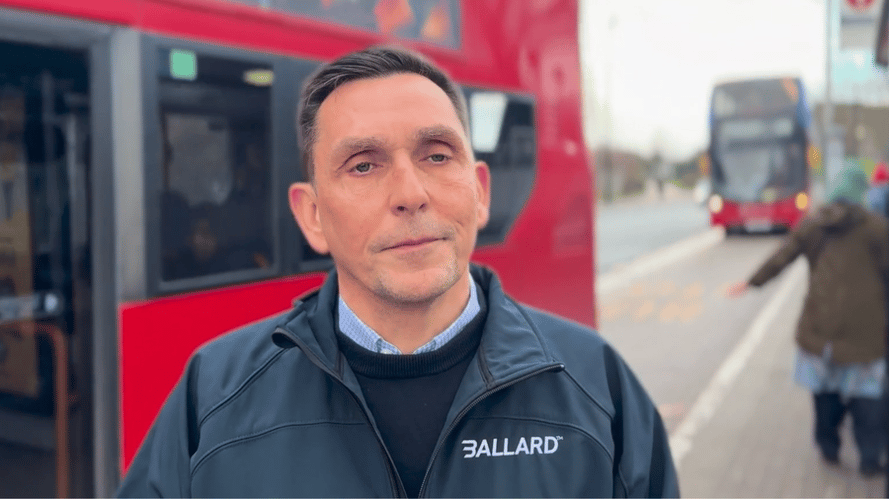
While diesel-hybrid buses may seem like a lower‑risk interim solution, they lock your agency into continued diesel dependence and harmful emissions; and leave you trailing in the race for zero-emission vehicle (ZEV) funding, regulatory compliance and meeting your sustainability goals. Choosing fuel cell electric buses (FCEB) is the smarter path that fully aligns with long‑term operational, environmental and financial objectives.
FCEBs are the only vehicles that provide a true one‑for‑one replacement of diesel buses, delivering all the benefits of zero‑emission operation – no tailpipe pollutants or greenhouse gases – without impacting service. With refueling times of just 10-15 minutes (as opposed to several hours for battery electric charging) and ranges of 400-500 miles per fill, FCEBs are especially well suited for long, high‑utilization routes.
Despite the current higher cost of vehicles, ongoing investments in fuel cell engines, hydrogen tanks, and electric drivetrains will reduce costs over time. In the meantime, to bridge the gap, FCEBs benefit from significant funding thanks to multiple state incentives.
This includes the Clean Vehicles Directive – requiring EU member states to meet minimum quotas for low-emission heavy-duty vehicles, including buses, in public procurements – and the Alternative Fuels Infrastructure Regulation – which requires hydrogen refueling stations to be deployed in all urban nodes and at every 200km along the Trans-European Transport (TEN-T) network by 2030. These mandates will contribute to achieving the EU’s goal that 90% of new urban public transit buses are zero-emission by the end of the decade.
From an operational standpoint, FCEBs provide a seamless transition from diesel, compressed natural gas (CNG), and diesel-hybrid buses to zero-emission alternatives, without compromising performance. These hydrogen-powered buses offer the benefits of electric drivetrains - such as high torque, quiet operation, and regenerative braking – but with on-board power generation, ensuring consistent performance even on demanding routes and in challenging weather conditions.
In contrast, while diesel-hybrid buses are sometimes viewed as a transitional option, they offer only limited environmental benefits, increased system complexity, and an uncertain long-term role:
- More complicated systems: Diesel-hybrid buses combine diesel engines with electric motors, batteries, and regenerative braking systems, making them more complex than conventional buses
- Higher maintenance demands: Specialized components require trained technicians and more expensive maintenance, which can offset some of the fuel savings
- Not zero-emission: Diesel-hybrid buses still rely on diesel fuel, so they continue to emit nitrogen oxides, particulate matters, and greenhouse gases
 Cologne's RVK was one of many fleet operators that benefited from the JIVE/JIVE 2 funding initiative in deploying hydrogen fuel cell-powered public transit buses on local routes
Cologne's RVK was one of many fleet operators that benefited from the JIVE/JIVE 2 funding initiative in deploying hydrogen fuel cell-powered public transit buses on local routes
As hybrid buses still depend on diesel, they fail to meet zero-emission regulations already in place in some states – and will fall even further out of compliance as the shift towards decarbonized transportation continues, regardless of changes in federal policy.
Moreover, diesel emissions are often concentrated in neighbourhoods near bus depots and high-traffic corridors – typically in disadvantaged communities. Zero-emission buses (ZEB) help eliminate these localized health burdens, especially when powered by clean energy sources.
Operationally, there are other key considerations for transit agencies related to routes and duty cycles that can impact the economics of using diesel-hybrid buses as a stop gap solution:
- Benefits depend on route: Hybrid systems are most effective in urban stop-and-go conditions. On flat, highway routes, they may offer minimal advantage
- Performance degradation: As hybrid components age, both emissions reductions and fuel‑efficiency gains will decline
- Short service life risk: A diesel-hybrid bus bought today will reach its midlife at the same time transit agencies are likely to be mandated to electrify, leading to early retirement of vehicles or complex and costly retrofits
- Increasing cost: There has been limited recent investment in diesel-hybrid powertrains for buses due to the lack of long-term demand. As a result, the price of these buses has increased significantly recently, and only little improvement in powertrain performances is expected in the future
- Rising costs: The lack of long-term demand has stopped investment in diesel-hybrid powertrains, driving up purchase prices. Very little improvement in powertrain performance can be expected going forward
.png?width=513&height=664&name=Bus%20Tech%20Table%20(1).png)
The operational benefits and environmental imperatives leave no doubt: the shift to zero-emission transit is irreversible. Across Europe, Asia, and North America, operators are abandoning internal‑combustion powertrains in favour of fully zero-emission fleets. While short‑term political cycles may sway regulations, the long‑term objective of 100% emission free transit remains unchanged.
This raises the question: Why invest in diesel hybrid buses – which have seen minimal powertrain improvements over the past five years – and risk being stranded for the next 12 years with obsolete technology, which will not meet current and future emission mandates?
In contrast, FCEBs offer a clear path forward, and the regulation framework, infrastructure support, and funding and innovation program backing is now in place to ensure success. Public demand for clean, quiet buses is overwhelming and reverting to diesel‑based systems will do little to meet commuter expectations.
Our cities deserve cleaner air and a sustainable transit future.